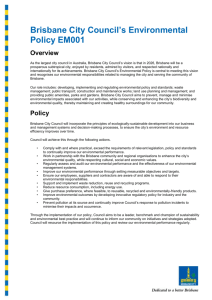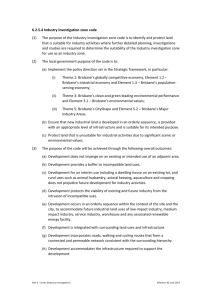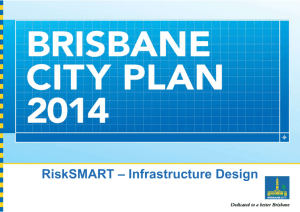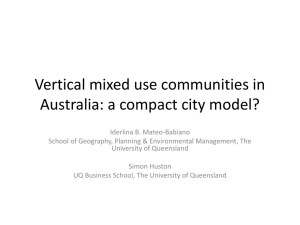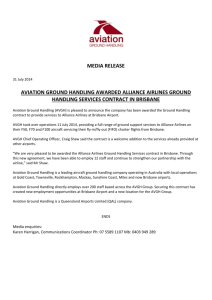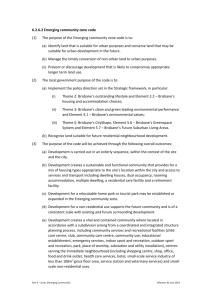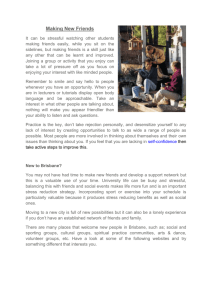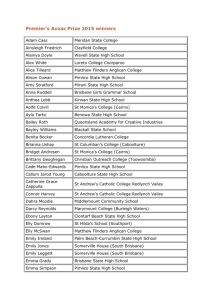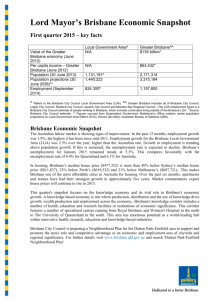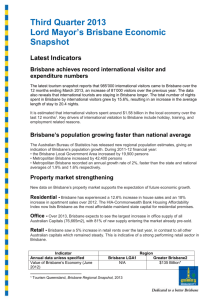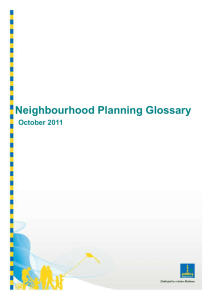Infrastructure Design Planning Scheme Policy (IDPSP)
advertisement
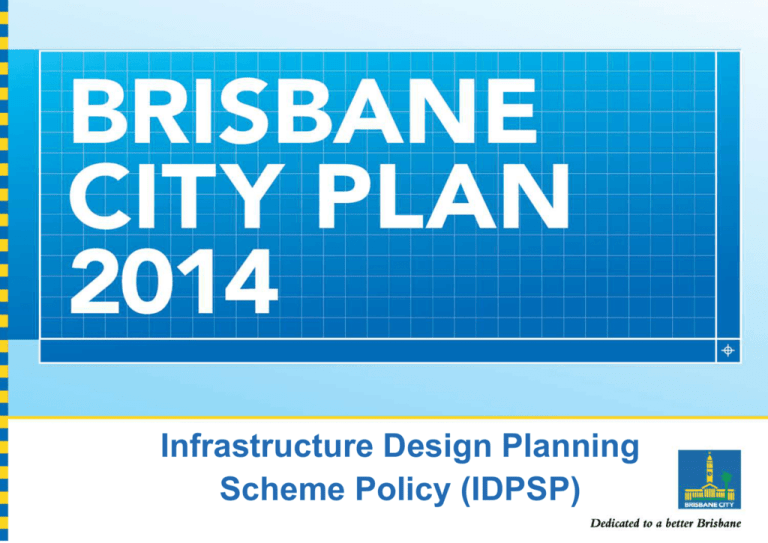
Infrastructure Design Planning Scheme Policy (IDPSP) Session Outline 1. Introduction 2. Comparison with Brisbane City Plan 2000 3. Purpose and role of Infrastructure design planning scheme policy (IDPSP) 4. Triggering the IDPSP 5. Content of the IDPSP Introduction Located in Schedule 6 of Brisbane City Plan 2014 Drafted in accordance with Queensland Planning Provisions Supersedes a large proportion of the current Subdivision and Development Guidelines, e.g. infrastructure design Parts of the guidelines not covered by the IDPSP will either be covered by a new development code within Brisbane City Plan 2014, e.g. Flood affected land, or contained within a new manual, e.g. processes for asset handover Excludes water and sewer standards (QUU) IDPSP Purpose and Role Covers broad range of infrastructure design standards ranging from road and drainage design requirements through to public art Infrastructure often handed over to Brisbane City Council as assets Not a procedures manual Does not contain statutory conditions Does not contain approval processes Does not contain assessment criteria like codes Triggering the IDPSP – Through a Code 9.4.4 Infrastructure design code: The purpose of the Infrastructure design code is to assess the suitability of infrastructure development. POs and AOs in this code reference IDPSP. IDPSP Contents Ch.1 Introduction • Provides a list of the codes in Brisbane City Plan 2014 where this policy is referenced • Outlines Brisbane City Council’s expectations for lodgement of design plans and reports, e.g. plans to be certified by an RPEQ • Provides some definitions specific to IDPSP Ch.2 Transport network • Establishes key requirements for the Brisbane transport network hierarchy, including road hierarchy, freight hierarchy, bicycle network and streetscape hierarchy • Some new naming conventions for road types Ch.3 Road corridor design • Sets the design standards for various road corridor types (refers to Brisbane City Council’s standard drawings and/or AUSTROADS where appropriate) • Includes elements such as on road bicycle requirements, verges, streetscape and wildlife movement IDPSP Contents Ch.4 Pathway design outside the road corridor • Requirements for pathways not located within the road reserve, e.g. bicycle and / or pedestrian pathways Ch.5 Streetscape locality advice • Replaces the existing centres design manual as well as streetscape requirements within existing neighbourhood plan areas • Provides urban design standards for aspects such as planting and path treatments Ch.6 Public art • Covers design requirements for public art installations • Includes requirements for visibility and position, materials, structural, lighting, installation and maintenance IDPSP Contents Ch.7 Stormwater drainage • Covers hydrology/hydraulics, drainage, water quality, design standards, lawful point of discharge (LPD), overland flow, channel design, easements and pumps (uses to Queensland Urban Design Manual (QUDM) and Brisbane City Council’s standard drawings) • Includes a simplified sizing method for detention storage for development sites < 2 ha • LPD and easement requirements may be reviewed in future based on new QUDM • Uses % Annual Exceedence Probability (AEP), rather than Average Recurrence Interval (ARI) IDPSP Contents Ch.8 Structures • Requirements for bridges, culverts, tunnels, earth retaining structures, water access structures, sea and river walls • Key reference is AS5100 Bridge Design Ch. 9 Public utilities • Standards for street lighting, electricity services, telecommunications (including Brisbane City Council telecommunication conduits) and traffic signals Ch.10 Parks • Requirements for park infrastructure, including planting, pathways, lighting, furniture, drinking fountains, public toilets, shelter structures, playgrounds and recreation facilities (e.g. sports ovals, skate board parks, dog off-leash areas), signage, public art, emergency vehicle access IDPSP Contents Ch.11 Public toilets • Location and design Ch.12 Public riverside facilities • Supersedes existing Public Riverside Facilities Design and Maintenance Manual (incorporates the majority of its content) • Covers revetment walls, material selection, pedestrian and bicycle pathways, structures over the river, balustrading and handrails, furniture (e.g. seating, shade structures), lighting, planting, signage and public art • Design life Ch.13 Community facilities • Sets the desired standards of service for community facilities, e.g. halls, libraries, public swimming pools Summary • Consistent with other local government areas • Infrastructure design provisions consolidated • Designed in collaboration with industry • Uses industry standards where possible • QPP compliant

